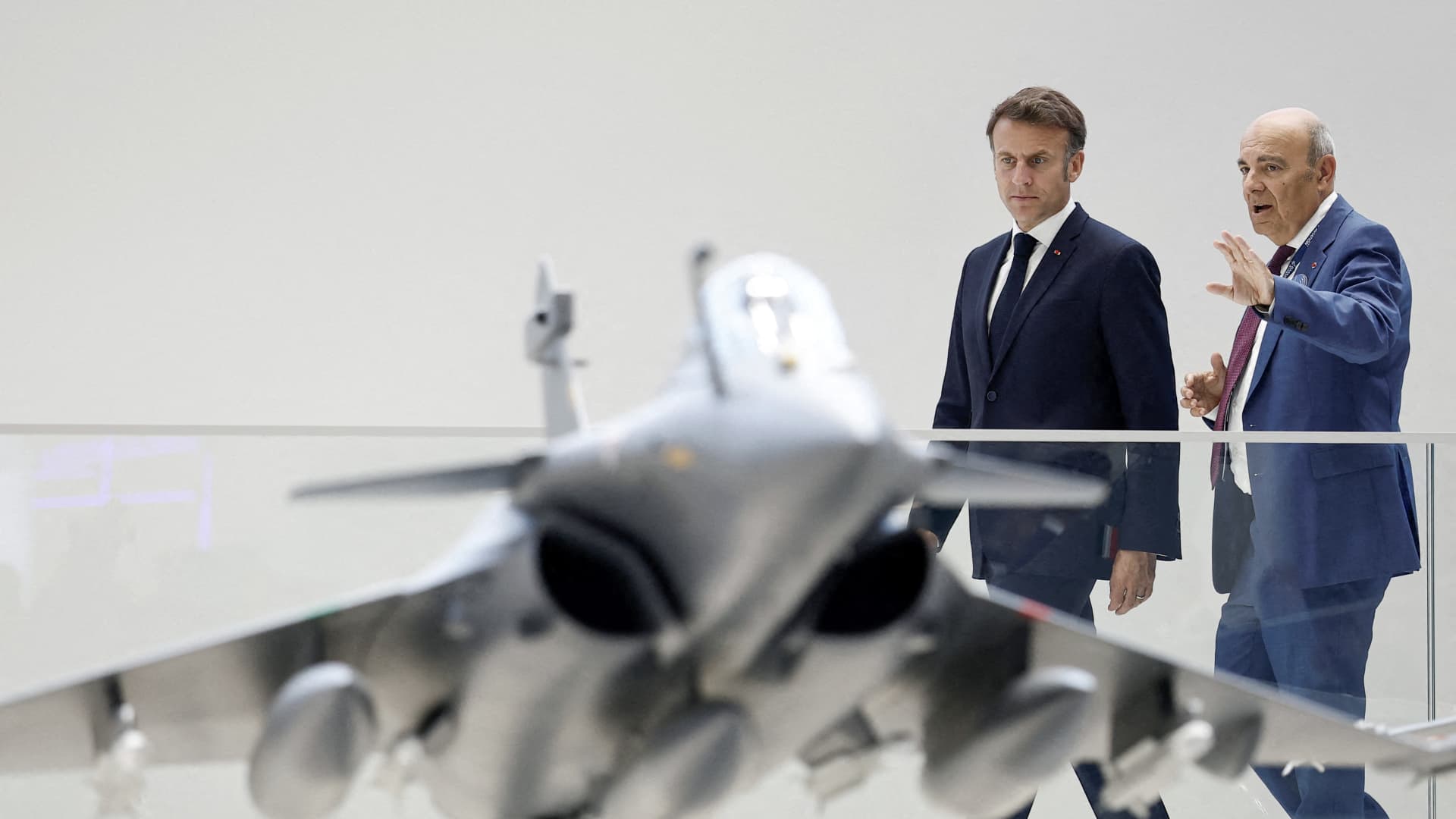Europe’s defense stocks wobbled at the start of the week, as investors pored over the details — still lacking in some areas — of the framework trade agreement struck by the U.S. and European Union on Sunday. An initial concern was that a commitment by the EU to increase its purchases of U.S. goods, in particular military equipment, could come at the cost of the European defense firms that have staged a massive rally this year on expectations of a regional spending spree . Those include France’s Thales , which fell 4.3% on Monday; Germany’s Renk and Rheinmetall , which were down 5.1% and 3.3%, respectively, and Italy’s Leonardo , which dipped 0.74%. Analysts told CNBC such fears were unfounded, and that European defense firms were set to remain the primary beneficiary of bigger national budgets in the coming years — particuarly since they lack the output capacity to meet all the region’s needs themselves. According to a White House summary of the deal, the EU would make $600 billion in new investments in the U.S. by the end of President Donald Trump’s term in 2028, in addition to the $100 billion that EU firms currently invest annually. It adds that the bloc “agreed to purchase significant amounts of U.S. military equipment,” with Trump telling reporters that it would make “hundreds of billions of dollars” of arms purchases. In its own read-out, the EU said only that companies in the bloc “have expressed interest in investing at least $600 billion” in “various sectors” in the U.S. by 2029, specifying instead its intention to buy 700 billion euros ($810 billion) worth of U.S. liquified natural gas, oil and nuclear energy products, and 40 billion euros worth of AI chips. European Commission President Ursula von der Leyen did not mention U.S. military purchases in her own statement on the deal , which comes two weeks after she put forward a proposed 2 trillion euro, seven-year budget including a fivefold increase from current spending on defense and space. Overall, the EU has this year outlined plans to mobilize around 800 million euros in new defense spending as part of a major rearmament push, including via loans and the relaxation of fiscal spending constraints. Lack of capacity The numbers mentioned in the trade agreement are a source of uncertainty, Peter Schaffrik, global macro strategist at RBC Capital Markets, told CNBC. “For defense in particular, this is relevant as we know that not all of the European spending can be done with European firms. Therefore, it is unclear whether the sums mentioned are in addition to what was planned, and whether the spending takes place over a short or long time frame (i.e. 10 years) is also highly uncertain.” U.S. military suppliers such as Lockheed Martin , Northrop Grumman and Raytheon were already expected to significantly benefit from higher EU spending as they extend existing contracts and win new ones, despite calls by European bosses and leaders to keep as much funding as possible in the region. Dmitrii Ponomarev, exchange traded fund product manager at investment management firm VanEck, noted that Europe accounted for approximately 35% of all U.S. arms exports between 2020 and 2024, and that the U.S. supplied about 64% of arms imported by European NATO states. The Stockholm International Peace Research Institute has “raised concerns about the EU’s ambitions for domestic defense manufacturers, citing historical difficulties in scaling up production, cost inflation from protectionist policies, and a persistent mismatch between supply and demand within the bloc,” Ponomarev said. “U.S. defense contractors are likely to be the primary beneficiaries of this deal. While European defense firms initially reacted negatively to the news, they could still benefit in the long term, assuming the overall size of the European defense market grows faster than local companies can absorb.” Push to spend local Capital will flow from private sector companies to where it’s seeking the highest return if the U.S. makes its economy, markets and regulation more attractive than Europe, said Dean Turner, chief euro zone and U.K. economist at UBS Global Wealth Management’s investment office. But from the current announcement, it remains hard to know what is new and additional or was going to happen anyway, he said. “In my mind, timing is the issue. If countries wish to invest in defense equipment, their procurement options at this stage are somewhat limited. In Europe we have lots of defende manufacturers, but probably not enough with capacity to deliver that kind of boost to output,” he said. “Of course some money will flow to the U.S., it has to as it’s the only provider of a number of key NATO-compliant defense systems. A lot will flow to the U.K. I’d still be of the view that it’s Europe’s intention, which [French President Emmanuel] Macron and others have been clear about, that much more of this spending has to be done locally.” “So just because of a trade agreement — I’d hesitate to even call it a deal at this point — it won’t be transformational in terms of U.S. defence.” ‘Smoke and mirrors’ Simon Evenett, professor of geopolitics and strategy at IMD business school and co-chair of the World Economic Forum’s Global Future Council on Trade and Investment, said the word “investment” is used “very loosely in all of the Trump trade deals,” including the recent announcement of a $600 billion U.S. investment commitment by Saudi Arabia . “You unpack it and it involves spending on defense, investments by the private sector, it involves a wide range of things. What does this mean in the context of the EU-US deal? At this stage, who knows,” Evenett said. The European Commission has signaled that the $600 billion refers to private sector investment, implying no additional spending by European governments beyond energy purchases, he said. “In short, this agreement involves a lot of smoke and mirrors … this deal just buys time for further specifics to be articulated.”





